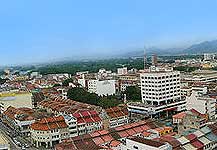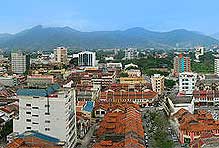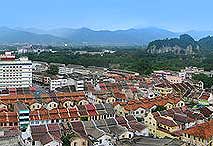Ipoh History Facts and Timeline
(Ipoh, Perak, Malaysia)

Until the 1820s, this inland city in the centre of the Malaysian peninsula was little more than thick jungle surrounded by limestone cliffs, at the highest navigable stretch on the Kinta River. But like so many areas of Malaysia, the arrival of the British here changed the history of Ipoh forever.
Tin Mining Town
The early history of Ipoh as a settlement was all down to its mining industry, although it did rather play second fiddle to nearby Gopeng, some 19 km / 12 miles to the south. The first incarnation of Ipoh did not last long, as a fire swept through the town in 1892, meaning that it needed to be subsequently rebuilt.
Over the next 100 years, Ipoh flourished as a tin mining community, prompting the arrival of major companies of the day on the back of its growing wealth. In 1902, the Chartered Bank of India, Australia and China opened an office here and this was swiftly followed by accounting firms, estate agents and brokers.

Chinese Expansion
By the 1930s, Ipoh was booming and serious money was being made here. It was during this period that Yau Tet-Shin, a wealthy Hakka from southern China, began to spend his millions on developing a new area of the city. Still called New Town today, this section runs from Greentown to the Kinta River.
The British were building a new railway station around the same time, which was completed in 1935 and the second in the city, further adding to the overall prosperity. Nicknamed the Taj Mahal of Ipoh by local residents, this striking colonial structure looks similar to that in the capital of
Kuala Lumpur and remains in superb condition, with its manicured lawns and gleaming white facade. Of interest, in 1999, it was used as a filming location in the movie Anna and the King, starring Jodie Foster.

Japanese Occupation
On 15th December 1941, the Japanese invaded Ipoh, along with many of the Malaya states, and quickly took over the city for the remainder of the war. It was during this period in the history of Ipoh that the city established itself as an administrative centre, as well as a commercial mining hub, and the Japanese made Ipoh the state capital of Perak instead of Taiping.
The Japanese administration was set up in St. Michael's Institution on the Jalan SP Seenivasagam, known as Clayton Road during the colonial period. Built in 1923, this magnificent structure served as a school and remains so today, whilst also being a major tourism site.
Post-War Heyday and Decline
After the British regained control of Ipoh following the end of World War II, the city became a centre of entertainment and the business community learned to let the good times roll. Cinema halls were built, so too were amusement parks, cabarets and after-hours clubs, as Ipoh became one of just four cities to be included among the first destinations served by Malaysian Airlines.
Tin had made Ipoh an international city that could be reached in a matter of hours from anywhere in East Asia. However, by the 1970s, the tin industry that had bolstered the local economy for so long had collapsed, prompting workers to find employment elsewhere in the newly independent Malaysia. Tourism, on the back of the colonial history, remains one of its biggest industries today.
 Until the 1820s, this inland city in the centre of the Malaysian peninsula was little more than thick jungle surrounded by limestone cliffs, at the highest navigable stretch on the Kinta River. But like so many areas of Malaysia, the arrival of the British here changed the history of Ipoh forever.
Until the 1820s, this inland city in the centre of the Malaysian peninsula was little more than thick jungle surrounded by limestone cliffs, at the highest navigable stretch on the Kinta River. But like so many areas of Malaysia, the arrival of the British here changed the history of Ipoh forever.
